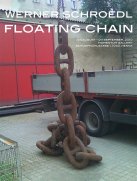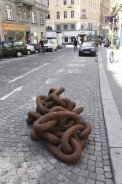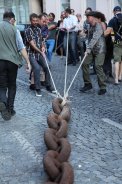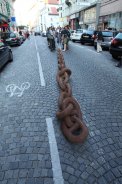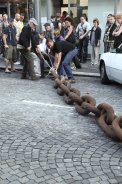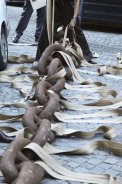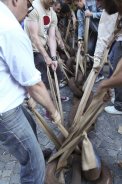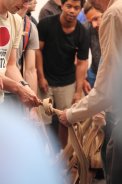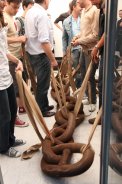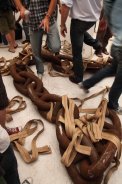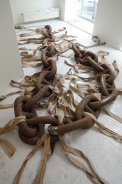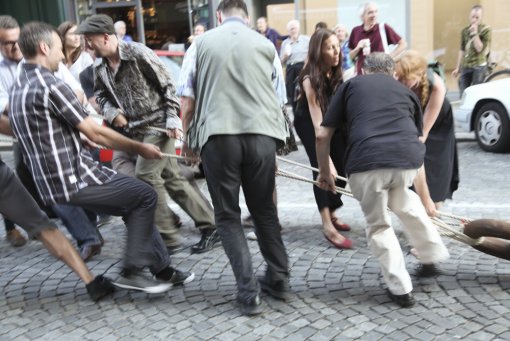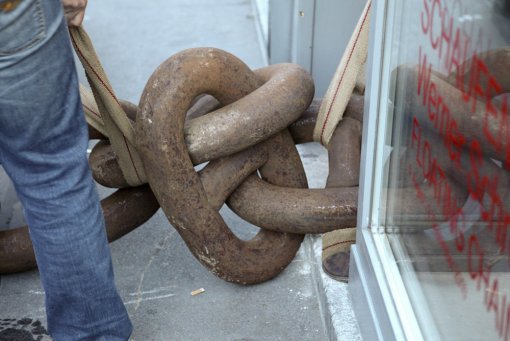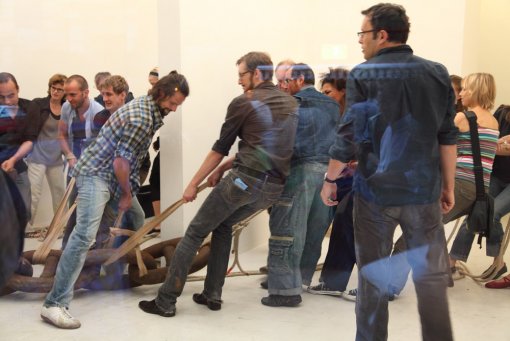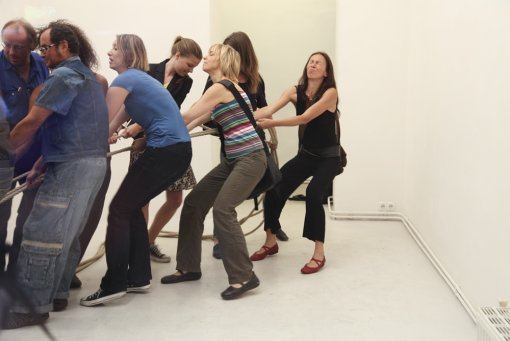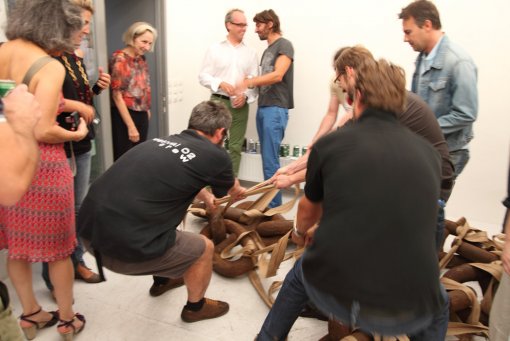2010
Fast zwei Tonnen Eisen verteilt auf 19 rostige Kettenglieder und acht Meter Länge ruhen am Galerieboden. Nur ein kleiner Teil einer Ankerkette, die mehr als 200 Meter lang, einmal dabei geholfen hat, einen Ozeanriesen aus Stahl am Meeresboden festzumachen, ihn in Position zu halten, ihn zu stabilisieren. Ein massives Stück oxidiertes Metall, an dem Sauerstoff und Salzwasser genagt haben, hat Werner Schroedl aus seinem Funktionszusammenhang gerissen und es „ablegen“ lassen. Im Raum der Galerie verweist das Objekt zwar einerseits auf seine Geschichte und auf seine industrielle Fertigung, ist aber andererseits weitaus mehr als ein in den White Cube transferiertes objet trouvé, weit mehr als ein auf ästhetische Qualitäten von Material und Form reduziertes Stück Minimal Art.
Wie ein monströses Tier liegt die ankerlose Kette und greift Glied für Glied Raum, besetzt den Platz auf eine Weise, der nicht widersprochen werden, an der auch gar nicht – selbst wenn man wollte – gerückt werden kann. Es scheint, als würde sich das Ungetüm hier aufladen, um seinen Zustand der unendlichen Schwere irgendwann aufs Neue zu überwinden. „Floating Chain“ heißt die Arbeit, die schwebend, fließend, treibend bereits im Titel die Trägheit ihrer Masse verneint. Nicht die Eisenkette selbst ist also die Skulptur, denn es geht um ihr Potenzial, um das, was aus ihr wird, um die Grenzen, die sie überschreitet. Skulptural ist vielmehr das, was veränderlich ist, das, was vergänglich und vorübergehend ist. Und darin fügt sich „Floating Chain“ in den Gesamtzusammenhang von Werner Schroedls Arbeiten: Es sind ephemere Skulpturen, die sich im Medium Fotografie manifestieren und im Ausreizen ihrer Möglichkeiten surreale, unwirkliche Momente produzieren. Wie groß kann ein Ballon sein? Wie schwer die Ankerkette? Wieviel Flitter verträgt der Himmel?
(Anne Katrin Feßler)
Eight meters in length, nearly two tons of iron in the form of 19 rusty links rest on the gallery floor. Just a small part of an anchor chain, originally over 200 meters long, that once firmly secured a seafaring steel giant to the ocean floor, maintaining position, steadfast. Air and seawater have left their mark on this massive assembly of oxidized iron, torn by Werner Schroedl from any functional cohesion and seemingly "discarded".
In the gallery space this object stands witness to its own history, its forging, but on the other hand is far more than the objet trouvé transferred to the White Cube, far more than a piece of minimal art reduced to its aesthetic qualities of material and shape.
Like a monstrous animal the anchor-less chain lies, and conquers the room, piece by piece, owning the space in a way that cannot be denied; a way in which – even if one so desired – cannot be advanced. It's almost as though this colossus is merely recharging before once again overcoming its state of infinite heaviness.
This work is called "Floating Chain", the title weightlessly, fluently, impulsively negating the inertia of its mass. The iron chain itself, then, is not the artwork; the subject is its potential for that which it will become, or even the boundaries it crosses.
Sculpturally, moreover, it is changeable, that which is fleeting and temporary. This is where "Floating Chain" finds its place in the overall relevance of Werner Schroedl's work: ephemeral sculptures that manifest themselves in the medium of photography and in exhausting their possibilities produce surreal, unreal moments. How big can a balloon be? How heavy an anchor chain? How much flitter can the heavens take?
